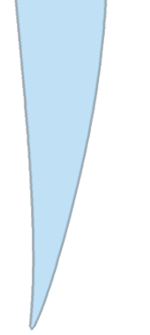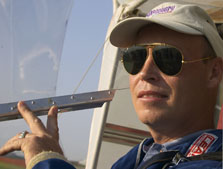

Pilot's Corner
Update
It flew! It flew! It flew!
 That’s all I shouted after exiting the nosed down flapper. It was only 14 seconds in the air but the most memorable and significant flight I have ever experienced.
That’s all I shouted after exiting the nosed down flapper. It was only 14 seconds in the air but the most memorable and significant flight I have ever experienced.
The test day of July 8th, 2006 of the ornithopther started normal and routine. I Arrived at Downsview about 5:30 and the team was well into the extensively tedious pre-flight checks and preparations. After rolling the aircraft out of the hanger, fueling and doing my walk around, we were ready for the pre-flight briefing and safety procedures.
The objective of the test was to see how the jet was performing. If everything was operating properly and the weather conditions co-operated, a flight attempt would be made with the consent of the team.
It had been almost a year since I had sat in the position of pilot of the ornithopther and it felt good to be there again.
The engine start and jet fire up went well. Our first run was to the south into the wind. Then over the course of two hours we made three more attempts. All the runs obtained speeds of 50 Mph plus but hard bouncing aborted these flight attempts. After the fourth run we went back to the taxi way at the north end of the runway. The flapper was then re-fueled and the decision was made to make one last attempt for the day. This run would be made to the south, the preferred direction, due to the light south west wind.
The engines were started and we were cleared to back track to the north. Reaching the end I did a 180 and without stopping power was added. Full jet and slowly increasing flapping frequency to 1.1, the acceleration seemed good. Approaching 50 Mph the aircraft started to bounce but not as badly as with the previous runs. At that point instead of backing off the power I eased back on the control stick and to my amazement the flapper broke free from the ground and began to fly with ease. Once in the air it was surprisingly smooth and easy to control.
Within 5 seconds into the flight I felt, what I would describe as, a tug on the left wing. At that point the flapper started to roll to the left and I corrected with right rudder. The bank angle got steeper and steeper to the point where I had to quickly reduce power. After chopping power the flapper settled onto the runway, left wheel first and then the nose wheel which collapsed. After a short skid on its nose the aircraft came to a stop, upright but with a broken nose gear. I used extreme caution and did exit the flapper very quickly in case of fire but there was none.
We initially thought that the roll was the result of the cross wind from the west. After further discussion and review of the footage that was taken of the flight it was determined that the trailing edge clips started to fail on the left wing. The damage was not severe and I was not injured and I feel this constitutes a successful first ornithopther flight.
Dr.DeLaurier along with the crew, past and present, should take pride in their accomplishment and perseverance with this project.
The ornithopther flew and I was fortunate enough to be the one at the controls. The experience was very personally rewarding. I am looking forward to any future testing.
July 8th, 2006 was a life experience, for me as an avid pilot, for the crew
who devoted so much of their lives to achieving this goal. It is as well a significant historical day for the world of aviation.
Jack Sanderson
Background 
I have been the pilot for Project Ornithopter for the last three testing seasons, and I am honored that I have been selected and accepted by the group of individuals that make up the team.
Here is a brief background of my flying experience before I give my thoughts and feeling of being in the cockpit of the ornithopter:
Growing up in an aviation-oriented family, I was exposed to a wide variety of flying. As early as age four I can remember having my hands on the controls of a Cessna 150 and by age fourteen I was flying hangliders and conventional gliders. I obtained my private pilots license when I was eighteen and gained experience flying the family Cessna 180, and then receiving a commercial ultra-light license a few years later. I have been flying, instructing, building homebuilt and ultra light aircraft since the early 1990’s.
In 1995 I was fortunate to be involved in the motion picture “Fly Away Home”, with the titles of being the primary pilot double for Anna Paquin and being the secondary pilot double for Jeff Daniels, flying the Cosmos trike was a priceless experience. I stay current by flying for pleasure from my backyard strip in Cannington, Ontario.
The Ornithopter: what
a machine! Climbing into the cockpit for the first time did not feel
that different from any other homebuilt that I had been in. It was the
atmosphere of the well-organized team approach that was unique for me.
The number of people that it takes to prepare the aircraft for testing
was amazing.
My level of familiarity changed dramatically as the engine cranked over and
started. It was very unusual and outright weird seeing the wings flapping.
The movement of the wings and feeling the reaction of that is quite the sensation.
Getting down to business, how do we attempt to fly this
bird? My initial taxi runs felt good, obtaining speeds in the low forties with
good directional control. The objective is to get up to the calculated rotation
speed, 54 – 56 mph, without producing unsafe loads to the aircraft. Instinctively
I was trying to fly the flapper off like a conventional aircraft. It was quickly
apparent to the team and me that this was the wrong technique. With numerous
taxi tests, computer simulations and discussions the best strategy was devised.
It was obvious that we would have to keep the three wheels planted as firmly
as possible until the calculated rotation speed was reached, which was seemingly
harder than it sounds. Working within a limited area, crosswinds and the natural
lifting forces on the flapping wings are some of the factors that made it difficult.
I know that with perseverance we will master this technique and get the ornithopter
airborne.
Everybody asks me what the cockpit environment is like. First of all it is a surreal experience to know that you are being propelled down the runway with only the wings flapping to give you thrust. The placement of the controls and the instruments are good and feel normal. The flapper is two-axis controlled: the rudder and elevator are on the center-mounted control stick and the rudder pedals only operate the steerable nose wheel, which I am quite used to from flying two-axis controlled ultra-light aircraft. There is a fair amount of up and down motion, which doesn’t bother me because I am securely strapped in and as well too busy to notice. All in all I find the experience extremely invigorating and enjoyable.
I am looking forward
to a new season of testing and camaraderie with the rest of the team.
I feel that with the right conditions we will be able to get the job
done.
Jack Sanderson
Copyright 2006 Project Ornithopter